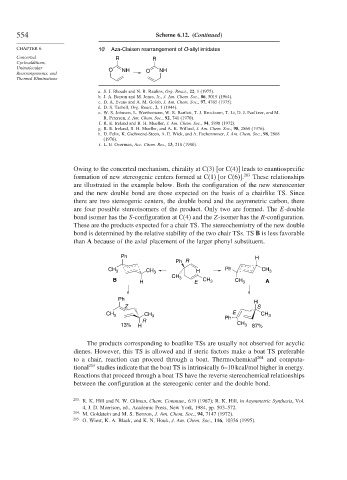Page 580 - Advanced Organic Chemistry Part B - Reactions & Synthesis
P. 580
554 Scheme 6.12. (Continued)
i
CHAPTER 6 10 Aza-Claisen rearrangement of O-allyl imidates
Concerted R R
Cycloadditions,
Unimolecular O NH NH
Rearrangements, and O
Thermal Eliminations
a. S. J. Rhoads and N. R. Raulins, Org. React., 22, 1 (1975).
b. J. A. Berson and M. Jones, Jr., J. Am. Chem. Soc., 86, 5019 (1964).
c. D. A. Evans and A. M. Golob, J. Am. Chem. Soc., 97, 4765 (1975).
d. D. S. Tarbell, Org. React., 2, 1 (1944).
e. W. S. Johnson, L. Werthemann, W. R. Bartlett, T. J. Brocksom, T. Li, D. J. Faulkner, and M.
R. Petersen, J. Am. Chem. Soc., 92, 741 (1970).
f. R. E. Ireland and R. H. Mueller, J. Am. Chem. Soc., 94, 5898 (1972).
g. R. E. Ireland, R. H. Mueller, and A. K. Willard, J. Am. Chem. Soc., 98, 2868 (1976).
h. D. Felix, K. Gschwend-Steen, A. E. Wick, and A. Eschenmoser, J. Am. Chem. Soc., 98, 2868
(1976).
i. L. E. Overman, Acc. Chem. Res., 13, 218 (1980).
Owing to the concerted mechanism, chirality at C(3) [or C(4)] leads to enantiospecific
formation of new stereogenic centers formed at C(1) [or C(6)]. 203 These relationships
are illustrated in the example below. Both the configuration of the new stereocenter
and the new double bond are those expected on the basis of a chairlike TS. Since
there are two stereogenic centers, the double bond and the asymmetric carbon, there
are four possible stereoisomers of the product. Only two are formed. The E-double
bond isomer has the S-configuration at C(4) and the Z-isomer has the R-configuration.
These are the products expected for a chair TS. The stereochemistry of the new double
bond is determined by the relative stability of the two chair TSs. TS B is less favorable
than A because of the axial placement of the larger phenyl substituent.
Ph H
Ph R
CH 3 CH 3 H Ph CH 3
CH
B H 3 E CH 3 CH 3 A
Ph
H
Z S
CH E
CH 3 3 Ph CH 3
R
13% H CH 3 87%
The products corresponding to boatlike TSs are usually not observed for acyclic
dienes. However, this TS is allowed and if steric factors make a boat TS preferable
to a chair, reaction can proceed through a boat. Thermochemical 204 and computa-
tional 205 studies indicate that the boat TS is intrinsically 6–10 kcal/mol higher in energy.
Reactions that proceed through a boat TS have the reverse stereochemical relationships
between the configuration at the stereogenic center and the double bond.
203 R. K. Hill and N. W. Gilman, Chem. Commun., 619 (1967); R. K. Hill, in Asymmetric Synthesis, Vol.
4, J. D. Morrison, ed., Academic Press, New York, 1984, pp. 503–572.
204 M. Goldstein and M. S. Benzon, J. Am. Chem. Soc., 94, 7147 (1972).
205
O. Wiest, K. A. Black, and K. N. Houk, J. Am. Chem. Soc., 116, 10336 (1995).

